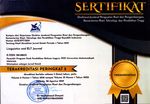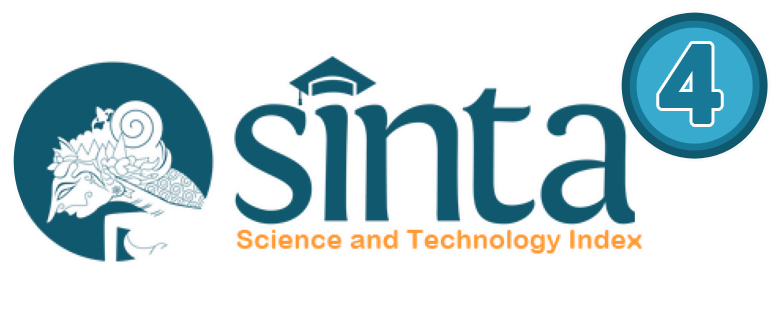Learning Process of Reading Multimodal Narrative Text: Promoting Students' Social and Emotional Competencies
Abstract
Keywords
Full Text:
PDFReferences
E. Emilia, D. Palupi, and F. Kusumawardani, “A Fresh Look at Students’ Ability to Read Multimodal Texts: A Case in Indonesia,” 2nd Int. Conf. Educ. Assess. Policy (ICEAP 2019), vol. 2, no. ICEAP, pp. 243–253, 2019, doi: 10.26499/iceap.v0i0.226.
M. Walsh, “Reading visual and multimodal texts: how is ‘reading’different?,” Proc. ALEA/UNE 2004 Conf. Multiliteracies English K-12 Age Inf. Commun. Technol. 2004, no. May, pp. 25–27, 2015, [Online]. Available: http://www.literacyeducators.com.au/docs/Reading multimodal texts.pdf
C. Jewitt, “Multimodality , ‘“ Reading ”’, and ‘“ Writing ”’ for the 21st Century,” vol. 26, no. 3, pp. 315–332, 2005, doi: 10.1080/01596300500200011.
T. Kress, G. & van Leeuwen, Multimodal Discourse. London, 2001.
M. Walsh, “Literacy and Learning with multimodal texts: classroom glimpses,” vol. 4 (1), 2015, [Online]. Available: https://www.researchgate.net/publication/242743792
L. Unsworth, “Multimodal reading comprehension: curriculum expectations and large-scale literacy testing practices,” Pedagogies, vol. 9, no. 1, pp. 26–44, 2014, doi: 10.1080/1554480X.2014.878968.
N. L. Group, “A pedagogy of multiliteracies: Designing social futures.,” Harv. Educ. Rev., vol. 66, no. 1, pp. 60-92., 1996, doi: https://doi.org/10.17763/haer.66.1.17370n67v22j160u.
S. S. Choo, “Writing through Visual Acts of Reading: Incorporating Visual Aesthetics in Integrated Writing and Reading Tasks,” High Sch. J., vol. 93, no. 4, pp. 166–176, 2010, doi: 10.1353/hsj.2010.0002.
A. Simpson and M. Walsh, “Children ’ s literature in the digital world How does multimodality support affective ,” 2015, doi: 10.1108/ETPC-12-2014-0005.
V. Nurviyani, D. Suherdi, and I. Lukmana, “Developing Students� Reading Skill Through Making Multimodal Inferences,” English Rev. J. English Educ., vol. 8, no. 2, p. 11, 2020, doi: 10.25134/erjee.v8i2.2998.
H. D. Brown and P. Abewickrama, Language Assessment: Principles and Classroom Practice, Second Edi. New York: Pearson Education, Inc., 2010.
K. Mills and B. Exley, “Narrative and Multimodality in English Language Arts Curricula: A Tale of Two Nations,” Lang. Arts, vol. 92, no. 2, p. 136, 2014.
M. Anderson and K. Anderson, Text Types in English 2. South Yarra, Australia: Macmillan Education Australia, 2003.
B. Derewianka, Exploring How Text Work. Australia: McPherson’s Printing Group, 2004.
V. Nurviyani, “The English Teachers’ Understanding of Genre Based Approach,” JOEPALLT, vol. 1, 2013.
R. Januarty and H. N. A. Nima, “Energizing students’ reading comprehension through multimodal texts,” Int. J. Lang. Educ., vol. 2, no. 2, pp. 14–22, 2018, doi: 10.26858/ijole.v2i2.4347.
K. Danielsson and S. Selander, “Reading Multimodal Texts for Learning – a Model for Cultivating Multimodal Literacy,” vol. 8, pp. 25–36, 2016.
R. Yawiloeng, “Using Instructional Scaffolding and Multimodal Texts to Enhance Reading Comprehension: Perceptions and Attitudes of EFL Students,” SSRN Electron. J., vol. 18, no. 2, pp. 877–894, 2022, doi: 10.2139/ssrn.4122231.
P. Abraham and M. Farías, “Reading with eyes wide open: Reflections on the impact of multimodal texts on second language reading,” Ikala, vol. 22, no. 1, pp. 57–70, 2017, doi: 10.17533/udea.ikala.v22n01a04.
K. Niemi, “CASEL Is Updating the Most Widely Recognized Definition of Social-Emotional Learning,” CASEL (the Collaborative for Academic, Social and Emotional Learning), 2020. https://www.the74million.org/article/niemi-casel-is-updating-the-most-widely-recognized-definition-of-social-emotional-learning-heres-why/
J. W. Creswell and J. D. Creswell, Research Design: Qualitative, Quantitative, and Mixed Methods Approaches, Fifth. Thousand Oaks, California: SAGE Publication Inc, 2018.
S. B. Merriam, Case Study Research in Education: A Qualitative Approach. San Francisco, US: Jossey Bass Publishers, 1991.
R. E. Stake, Multiple Case Study Analysis. New York, United State: The Guilford Press, 2006.
C. Dawson, Introduction to Research Methods: A Practical Guide for Enyone Undertaking a Research Project., Fourth. Oxford, United Kingdom: How to Books Ltd, 2009.
J. Heigham and R. A. Croker, Qualitative Research in Applied Linguistics: A Practical Introduction. New York: Palgrave Macmillan, 2009.
N. K. Duke and M. H. Mallette, Literacy Research Methodologies, Second. New York, United State: The Guilford Press, 2011.
M. B. Miles, A. M. Huberman, and J. Saldana, Qualitative Data Analysis: A Methods Sources, Third. London, United Kingdom: SAGE Publication Inc, 2014.
Y.-L. Lai, Y.-J. Tung, and S.-Y. Luo, “Theory of Reading Strategies and its Application by EFL Learners: Reflections on Two Case Studies,” 2008.
N. K. Denzin and Y. S. Lincoln, The SAGE Handbook of Qualitative Research, Fifth., vol. 53, no. 9. London, United Kingdom: SAGE Publication Inc, 2018. doi: 10.1017/CBO9781107415324.004.
U. Flick, The SAGE Handbook of Qualitative Data Collection, vol. 53, no. 9. London, United Kingdom: SAGE Publication Inc, 2018. doi: 10.1017/CBO9781107415324.004.
Z. Dornyei, Research Methods in Applied Linguistics, Quantitative, Qualitative and mix methodology. Oxford: Oxford University Press, 2007.
G. Woolley, “Developing reading comprehension: combining visual and verbal cognitive processes,” Aust. J. Lang. Lit., vol. 33, no. 2, pp. 108–125, 2010.
S. Harvey and A. Goudvis, Strategies that Work: Teaching comprehension for Understanding, Engagement, and Building Knowledge, Third Edit. Portland, Maine: Stenhouse Publishers, 2017.
W. Grabe and F. L. Stoller, Teaching and Researching Raading, Second. London: Routledge, 2011.
K. S. Goodman, “Reading: A Psycholinguistic Guessing Game,” 1967.
E. L. Thorndike, “Reading as Reasoning: a Study of Mistakes in Paragraph Reading,” J. Educ. Psychol., vol. VIII, no. 6, pp. 323–332, 1917.
P. D. Pearson and G. Cervetti, “Fifty Years of Reading Comprehension Theory and Practice,” in Research-Based Practice for Teaching Common Core Literacy, no. April, New York: Colombia University, 2015, pp. 1–40.
DOI: https://doi.org/10.31764/leltj.v11i1.15528
Refbacks
- There are currently no refbacks.
Copyright (c) 2023 Vina Nurviyani

This work is licensed under a Creative Commons Attribution-ShareAlike 4.0 International License.
_____________________________________________________
Linguistics and ELT Journal
p-ISSN 2339-2940 | e-ISSN 2614-8633

LELTJ is licensed under a Creative Commons Attribution-ShareAlike 4.0 International License.
_____________________________________________________
LELTJ is abstracting & indexing in the following databases:
_____________________________________________________
LELTJ Editorial Office:













